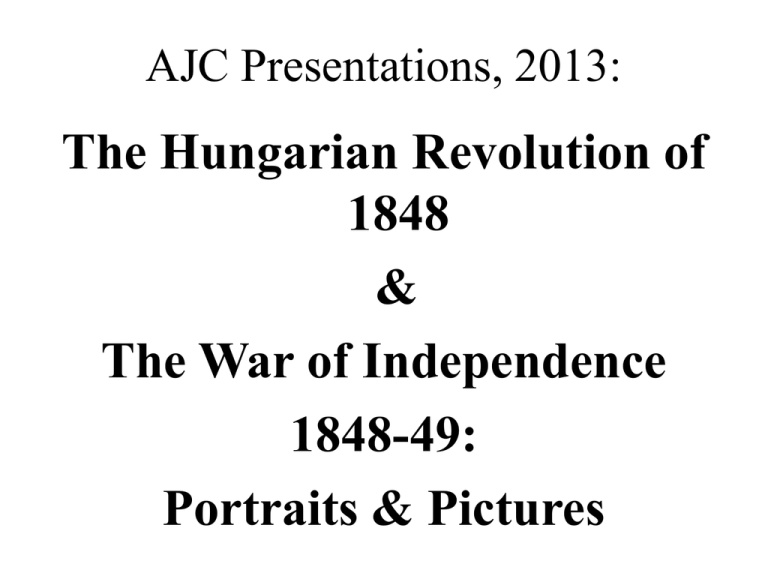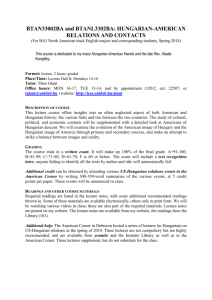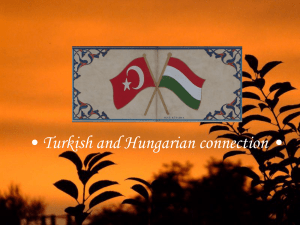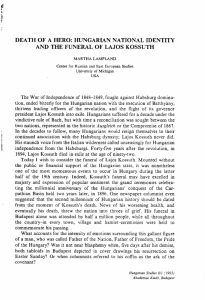The Hungarian Revolution and War of Independence, 1848-9
advertisement

AJC Presentations, 2013: The Hungarian Revolution of 1848 & The War of Independence 1848-49: Portraits & Pictures Sándor Petőfi, author of The National Song (1848) An early photographic fragment showing Sándor Petőfi, one of the first of its kind in Hungary, from 1847. It can be considered a faithful representation of the poet's features, which were over-romanticised in later portraits, such as the one on the first slide. He fell on the battlefield at Segesvár. The inhabitants of Pest submit a twelve-point petition to the City Council An engraving from the 25th March 1848 issue of Képes Újság. On 15th March, the Council opened the doors to the people, locked for centuries, and signed the petition, passing it to the Parliament. Besides freedom of the press, the petition also called for the abolition of serfdom, civil and religious equality before the law, the freeing of political prisoners and union with Transylvania. War of Independence, 1848-9 The First Hungarian Government was a coaltion balancing different tendencies. It resigned in October and was replaced by the Committee of National Defense, led by Kossuth. The Revolutionary Army crossed into Austria, in support of the uprising there, but halted before Vienna and was defeated by the imperial troops besieging the city. Ferdinand V was forced to resign, to be replaced by his nephew, Francis Joseph I (18481916). Imperial forces occupied both Buda and Pest, though the Hungarians won victories in Transylvania under the Polish General Bem. However, the Commander-in-chief of the Army, Artúr Görgey, was constantly in conflict with Kossuth. The capture of Buda Castle, May 21st, 1849. During the seesawing battles that took place in the War of Independence from Vienna to Transylvania, Buda, Pest and Óbuda fell to the Austrians without direct combat, and the Hungarian government fled to Debrecen. However, the rebel army laid siege to it at the beginning of May, 1849, and captured it on 21st, without real casualties. It was retaken by the imperial troops in July. Although the inhabitants of the capital played a major role in the events of March 1848, they seem to have endured the subsequent events with little involvement, other than providing soldiers. The surrender at Világos, August 1849 (painted 1851). In mid-August 1849, after the collapse of political confidence in Kossuth, Görgey, commander-in-chief, surrendered not only his own forces, but also the remaining scattered forces, to the Russian armies near Arad in Transylvania. He was given a personal amnesty, but the Austrian general, Haynau, camped nearby, carried out mass reprisals on the Hungarian troops. The Martyrs of 6th October, 1849 On this date, the Austrian FieldMarshal Haynau carried out the death sentence on thirteen generals, executing them by hanging/ firing squad. More than a hundred other revolutionaries were executed and thousands were imprisoned. Tens of thousands of ordinary soldiers were drafted into the imperial army and forced to serve in far away parts of the empire. Count Lajos Batthyány was also executed in Pest on 6th October. Haynau was soon relieved of his command in Hungary. The Aftermath of Defeat After 1849, the Austrians developed a new form of absolutism that tried to maintain the status quo while at the same time allowing for inevitable progress. The Hungarian reformists and revolutionaries, or rather those that had escaped prison, pinned their hopes on Garibaldi in Italy and Napoleon III in France. There was a growing dependence on the myths and legends of 1848-9, most notably connected to the poet Petőfi, whose death many refused to accept. Kossuth’s tours of Britain and America were successful in gathering sympathy, but no more. Count István Széchenyi, whom Kossuth had called ‘the greatest Hungarian’ was so depressed by the outcome of the revolution that, in 1860, he shot himself in the head in an asylum near Vienna.











